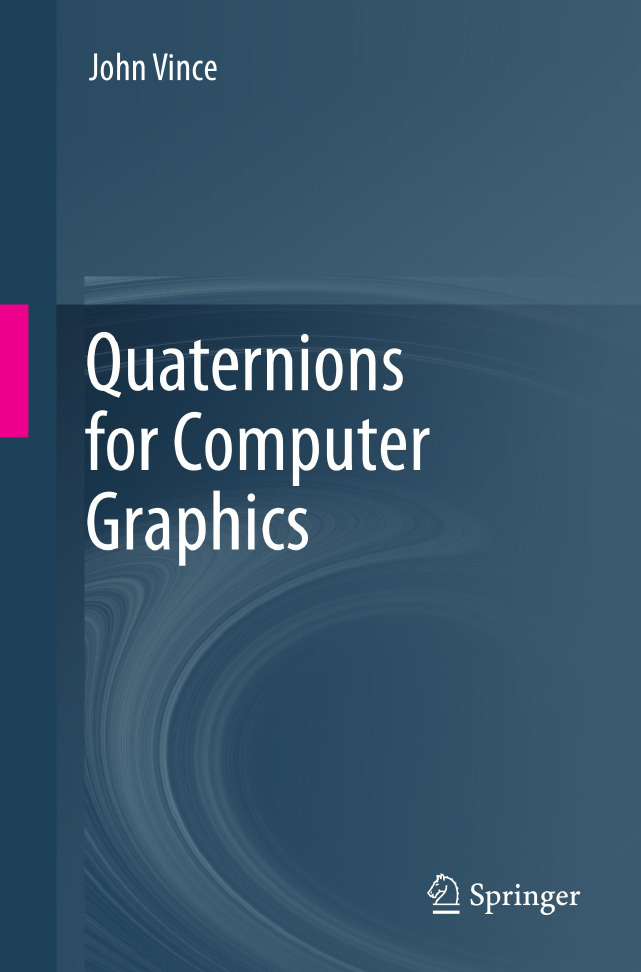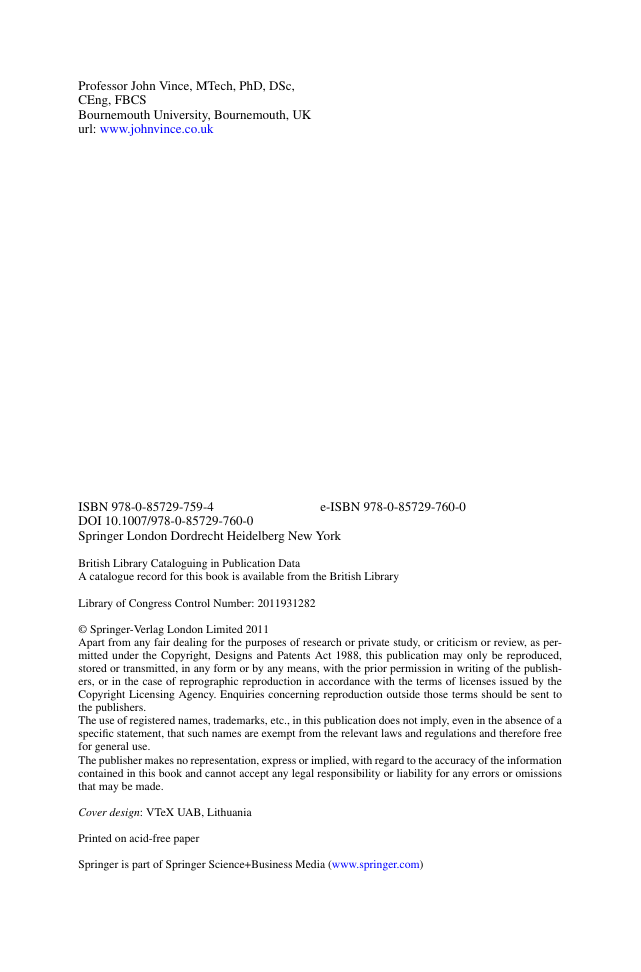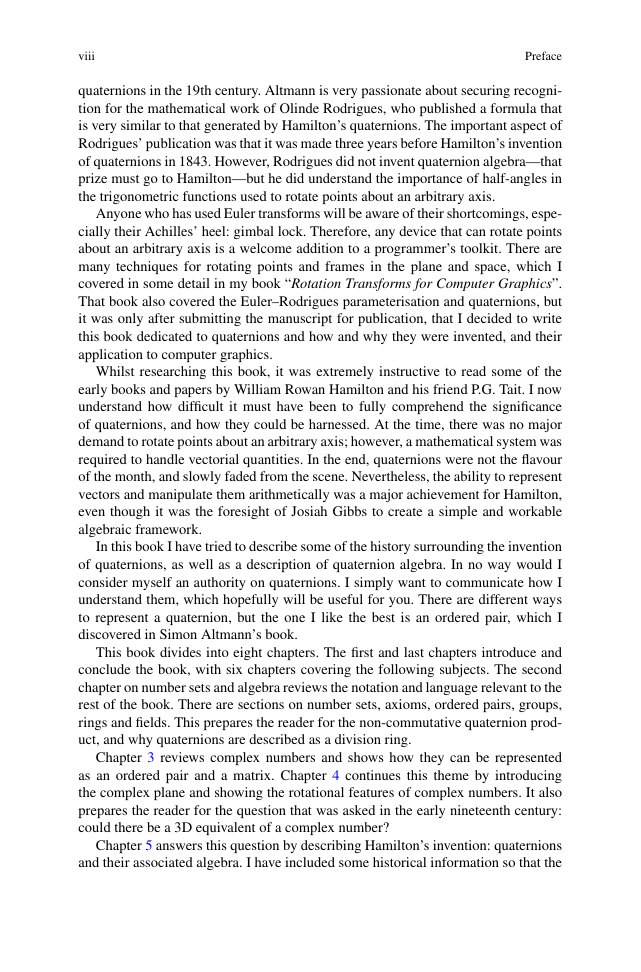Quaternions for Computer Graphics
Preface
Contents
Chapter 1: Introduction
1.1 Rotation Transforms
1.2 The Reader
1.3 Aims and Objectives of This Book
1.4 Mathematical Techniques
1.5 Assumptions Made in This Book
Chapter 2: Number Sets and Algebra
2.1 Introduction
2.2 Number Sets
2.2.1 Natural Numbers
2.2.2 Real Numbers
2.2.3 Integers
2.2.4 Rational Numbers
2.3 Arithmetic Operations
2.4 Axioms
2.5 Expressions
2.6 Equations
2.7 Ordered Pairs
2.8 Groups, Rings and Fields
2.8.1 Groups
2.8.2 Abelian Group
2.8.3 Rings
2.8.4 Fields
2.8.5 Division Ring
2.9 Summary
2.9.1 Summary of Definitions
Chapter 3: Complex Numbers
3.1 Introduction
3.2 Imaginary Numbers
3.3 Powers of i
3.4 Complex Numbers
3.5 Adding and Subtracting Complex Numbers
3.6 Multiplying a Complex Number by a Scalar
3.7 Complex Number Products
3.7.1 Square of a Complex Number
3.8 Norm of a Complex Number
3.9 Complex Conjugate
3.10 Quotient of Two Complex Numbers
3.11 Inverse of a Complex Number
3.12 Square-Root of i
3.13 Field Structure
3.14 Ordered Pairs
3.14.1 Multiplying by a Scalar
3.14.2 Complex Conjugate
3.14.3 Quotient
3.14.4 Inverse
3.15 Matrix Representation of a Complex Number
3.15.1 Adding and Subtracting
3.15.2 The Product
3.15.3 The Square of the Norm
3.15.4 The Complex Conjugate
3.15.5 The Inverse
3.15.6 Quotient
3.16 Summary
3.16.1 Summary of Operations
3.17 Worked Examples
Chapter 4: The Complex Plane
4.1 Introduction
4.2 Some History
4.3 The Complex Plane
4.4 Polar Representation
4.5 Rotors
4.6 Summary
4.6.1 Summary of Operations
4.7 Worked Examples
Chapter 5: Quaternion Algebra
5.1 Introduction
5.2 Some History
5.3 Defining a Quaternion
5.3.1 The Quaternion Units
5.3.2 Example of Quaternion Products
5.4 Algebraic Definition
5.5 Adding and Subtracting Quaternions
5.6 Real Quaternion
5.7 Multiplying a Quaternion by a Scalar
5.8 Pure Quaternion
5.9 Unit Quaternion
5.10 Additive Form of a Quaternion
5.11 Binary Form of a Quaternion
5.12 The Conjugate
5.13 Norm of a Quaternion
5.14 Normalised Quaternion
5.15 Quaternion Products
5.15.1 Product of Pure Quaternions
5.15.2 Product of Two Unit-Norm Quaternions
5.15.3 Square of a Quaternion
5.15.4 Norm of the Quaternion Product
5.16 Inverse Quaternion
5.17 Matrices
5.17.1 Orthogonal Matrix
5.18 Quaternion Algebra
5.19 Summary
5.19.1 Summary of Operations
5.20 Worked Examples
Chapter 6: 3D Rotation Transforms
6.1 Introduction
6.2 3D Rotation Transforms
6.3 Rotating About a Cartesian Axis
6.4 Rotate About an Off-Set Axis
6.5 Composite Rotations
6.6 Rotating About an Arbitrary Axis
6.6.1 Matrices
6.6.2 Vectors
6.7 Summary
6.7.1 Summary of Transforms
6.8 Worked Examples
Chapter 7: Quaternions in Space
7.1 Introduction
7.2 Some History
7.2.1 Composition Algebras
7.3 Quaternion Products
7.3.1 Special Case
7.3.2 General Case
7.4 Quaternions in Matrix Form
7.4.1 Vector Method
7.4.2 Matrix Method
7.4.3 Geometric Verification
7.5 Multiple Rotations
7.6 Eigenvalue and Eigenvector
7.7 Rotating About an Off-Set Axis
7.8 Frames of Reference
7.9 Interpolating Quaternions
7.10 Converting a Rotation Matrix to a Quaternion
7.11 Euler Angles to Quaternion
7.12 Summary
7.12.1 Summary of Operations
7.13 Worked Examples
Chapter 8: Conclusion
Appendix : Eigenvectors and Eigenvalues
References
Index
















 2023年江西萍乡中考道德与法治真题及答案.doc
2023年江西萍乡中考道德与法治真题及答案.doc 2012年重庆南川中考生物真题及答案.doc
2012年重庆南川中考生物真题及答案.doc 2013年江西师范大学地理学综合及文艺理论基础考研真题.doc
2013年江西师范大学地理学综合及文艺理论基础考研真题.doc 2020年四川甘孜小升初语文真题及答案I卷.doc
2020年四川甘孜小升初语文真题及答案I卷.doc 2020年注册岩土工程师专业基础考试真题及答案.doc
2020年注册岩土工程师专业基础考试真题及答案.doc 2023-2024学年福建省厦门市九年级上学期数学月考试题及答案.doc
2023-2024学年福建省厦门市九年级上学期数学月考试题及答案.doc 2021-2022学年辽宁省沈阳市大东区九年级上学期语文期末试题及答案.doc
2021-2022学年辽宁省沈阳市大东区九年级上学期语文期末试题及答案.doc 2022-2023学年北京东城区初三第一学期物理期末试卷及答案.doc
2022-2023学年北京东城区初三第一学期物理期末试卷及答案.doc 2018上半年江西教师资格初中地理学科知识与教学能力真题及答案.doc
2018上半年江西教师资格初中地理学科知识与教学能力真题及答案.doc 2012年河北国家公务员申论考试真题及答案-省级.doc
2012年河北国家公务员申论考试真题及答案-省级.doc 2020-2021学年江苏省扬州市江都区邵樊片九年级上学期数学第一次质量检测试题及答案.doc
2020-2021学年江苏省扬州市江都区邵樊片九年级上学期数学第一次质量检测试题及答案.doc 2022下半年黑龙江教师资格证中学综合素质真题及答案.doc
2022下半年黑龙江教师资格证中学综合素质真题及答案.doc